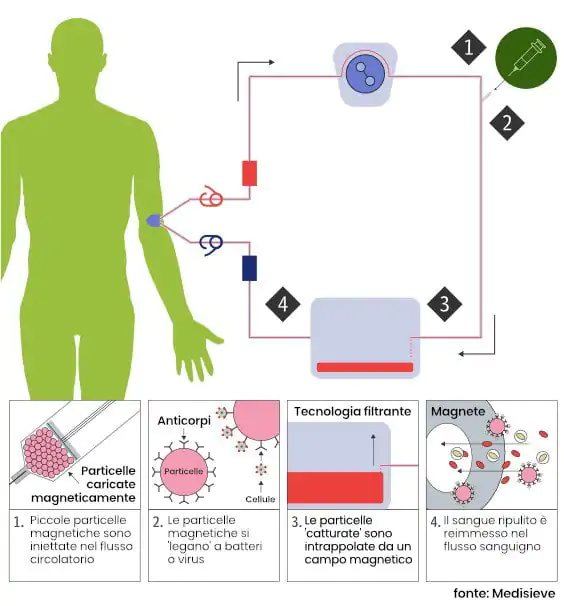Even fatal diseases like leukemia, sepsis and malaria could be eliminated from the body using magnets, after a British engineer designed a filtering system that can literally sift through blood.
Doctor George Frodsham came up with the idea for magnetic blood cleaning technology while studying the creation of magnetic nanoparticles that bind to cells in the body, to better highlight them in diagnostic tests.

He realized that if it is possible to magnetize cells for imaging, once 'hooked' they can also be dragged away by the blood.
In theory, any virus, bacterial infection, or even blood cancer can be grabbed by a tiny magnetic particle and removed from the body without the need for lengthy treatments with aggressive drugs.
The first human trials of magnetic blood cleaning technology (called MediSieve) are awaiting approval from the Medicines and Healthcare products Regulatory Agency (MHRA) and are likely to begin in 2020 with the first malaria trials. Those for sepsis will follow in 2021, to see if the device can reduce this deadly immune response.
Doctor FrodshamCEO MediSieve, a spin-off from University College London (UCL), said: “In theory we can capture almost anything. Poisons, pathogens, viruses, anything we can bind to specifically. It is potentially an extraordinary tool. When someone has a tumor it is removed surgically: leukemia is a tumor in the blood, so why not remove it using magnets? Now we know that it is possible. We just need to perfect the details.".
How magnetic blood cleaning works

The filtration system works similarly to dialysis. Blood is removed from the patient and infused with tiny magnetic particles that bind to the specific disease. These bound substances are then trapped in the system using magnets and the “clean” blood is pumped back into the body.
Blood may pass through the system several times until the disease is at such low levels that it can be removed by the immune system or a short course of medication. And the whole process will probably just take two to four hours, with some possible repetitions.
With malaria it is (theoretically) easier
Curiously, malaria naturally becomes magnetic when it enters the body because it affects iron-rich red blood cells, which means that the first step in cleansing the blood is not necessary.
“The malaria parasite invades red blood cells and consumes hemoglobin, then leaves an iron-based waste product, which it then takes into itself.”, he added Frodsham.
“We can never get to 100%, but even 99% is enough to be able to rely on the body or drug therapy to eliminate the rest. "
The approach to leukemia
“Unfortunately, leukemia cells do not all circulate in the blood. Some remain in the bone marrow and lymph nodes. The only way to cure blood cancers such as leukemia is to completely eliminate these cells, otherwise the cancer will return. But by removing cancer cells from the body rather than killing them with drugs inside the body, this approach could reduce the need for drugs with toxic side effects.”
Columbus' egg
Surprising as it may seem, for decades researchers have used antibodies attached to tiny magnetic beads to discriminate which cells to study in their experiments.
Dr. Frodsham hopes the device will inspire a new generation of engineers to find technological solutions to major medical problems rather than finding new drugs.
“We put on blinders. Anyone looking for solutions to malaria thinks only of new drugs, and it hadn't occurred to anyone that a device could be used."
George Frodsham Medisieve
Engineering is an option
In hospitals, a lot is what comes from the work of engineers. All medical and surgical equipment, diagnostics, treatment instruments.
“Those who are looking for a potential career that can change the world and benefit people but don't want to be a doctor can pursue engineering. It could have a much bigger impact. A doctor will never treat a million people, but an engineer might.”


